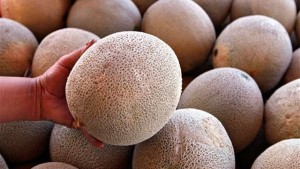In the fall of 2011, listeria-in-cantaloupe killed 33 people and sickened 147 in the U.S. Fault was found with the growers, the packing shed and dump tank where cantaloupes were washed before being shipped, and a porous food safety audit process.
 But was there something about the strains of Listeria involved that made this outbreak particularly deadly?
But was there something about the strains of Listeria involved that made this outbreak particularly deadly?
The 2011 listeriosis outbreak attributed to whole cantaloupe involved several genetically distinct strains of serotypes 1/2a and 1/2b that had not been previously reported in invasive listeriosis outbreaks.
Here we investigated the potential of strains from the 2011 cantaloupe outbreak to adhere, survive, and grow on cantaloupe rind and flesh and in juice extracted from cantaloupe at different temperatures (4, 8, and 25°C). All strains were able to adhere and grow, with ∼10-fold increases after 7 days at 4 or 8°C and after 24 h at 25°C, with a propensity for more growth on rind than on flesh or in extract. No significant differences in growth potential were noted among the different strains or between them and unrelated strains from other listeriosis outbreaks involving celery, deli meats, or hot dogs. Similarly to the cantaloupe outbreak strains, these other strains exhibited greater propensity for growth on rind than on flesh or in extract. Rinsing of cantaloupe fragments in sterile water resulted in temporary reductions of the populations by 50- to 100-fold, suggesting the potential of such washing to reduce risk if the produce is promptly consumed.
The absence of marked differences in adherence or growth between the cantaloupe outbreak strains and strains from other outbreaks highlights the need to further characterize the 2011 cantaloupe outbreak strains and elucidate potential biological attributes that contributed to their implication in the outbreak.
Capacity of Listeria monocytogenes strains from the 2011 cantaloupe outbreak to adhere, survive, and grow on cantaloupe
Journal of Food Protection®, Number 5, May 2016, pp. 696-889, pp. 757-763(7)
Martinez, Mira Rakic; Osborne, Jason; Jayeola, Victor Oladimeji; Katic, Vera; Kathariou, Sophia
http://www.ingentaconnect.com/contentone/iafp/jfp/2016/00000079/00000005/art00009
